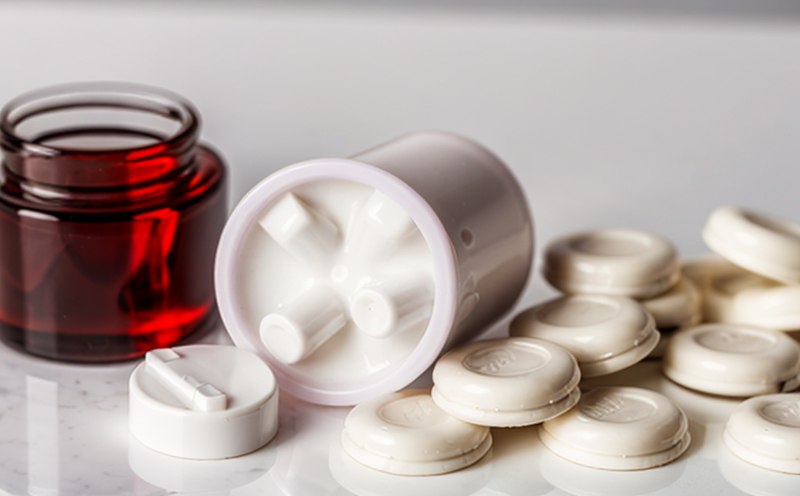USP Tablet Coating Cracking Resistance Testing
The USP Tablet Coating Cracking Resistance Test is a critical procedure used to evaluate the integrity and durability of coating on oral solid dosage forms. This test ensures that coatings are robust enough to withstand processing, storage conditions, and end-use handling without compromising their stability or efficacy.
In pharmaceutical manufacturing, tablets often undergo various stressors during production, packaging, shipping, and administration. These include mechanical abrasion, humidity, temperature fluctuations, and chemical exposure. The USP Tablet Coating Cracking Resistance Test quantifies the resistance of these coatings to cracking under simulated real-world conditions, thereby ensuring product quality and patient safety.
The test is conducted according to USP guidelines, which provide stringent standards for pharmaceutical testing. The method involves subjecting coated tablets to a series of mechanical stresses designed to mimic the conditions they might encounter during processing or use. The primary objective is to assess whether the coating remains intact and functional throughout these processes.
The test apparatus typically includes specialized equipment capable of applying controlled loads and measuring the force required to initiate and propagate cracks in the coating. This allows for precise quantification of cracking resistance, which can vary significantly among different formulations and excipients used.
Preparation of specimens for this test is critical. The coated tablets should be uniformly prepared according to standard practices outlined by USP guidelines. Once prepared, they are subjected to a series of mechanical stresses, including frictional forces and impact loads, designed to simulate the conditions they might encounter during processing or use.
Instrumentation used in these tests includes high-precision load cells, displacement sensors, and data acquisition systems capable of recording detailed force-displacement curves. These instruments provide valuable insights into the behavior of coatings under stress, allowing for accurate assessment of their cracking resistance.
The acceptance criteria for this test are based on predefined thresholds that indicate acceptable performance levels. If a coating fails to meet these criteria, it may be indicative of issues with its formulation or manufacturing process. In such cases, further investigation and corrective actions might be necessary to ensure product quality and compliance with regulatory requirements.
Quality and Reliability Assurance
- The USP Tablet Coating Cracking Resistance Test is a vital tool in maintaining the integrity of pharmaceutical coatings, ensuring they remain stable and effective throughout their lifecycle.
- This test helps identify potential weaknesses in coating formulations that could lead to performance issues during processing or use.
| Test Parameter | Description |
|---|---|
| Load Applied | The force applied to initiate and propagate cracks in the coating. |
| Crack Propagation Distance | The length of crack propagation after load application. |
| Specimen Size | Diameter and thickness of coated tablets used for testing. |
| Test Duration | The time period over which the test is conducted to assess long-term performance. |
Competitive Advantage and Market Impact
Adhering to rigorous testing protocols such as the USP Tablet Coating Cracking Resistance Test provides several competitive advantages for pharmaceutical manufacturers. By ensuring that coatings meet stringent quality standards, companies can enhance their reputation for producing high-quality products.
Compliance with these tests demonstrates a commitment to maintaining consistent product quality and reliability across all batches produced. This not only builds trust with regulatory bodies but also fosters confidence among healthcare professionals and consumers alike. Additionally, successful completion of such tests can open doors to new markets and opportunities for collaboration with leading industry players.
In today’s highly regulated environment, pharmaceutical companies must continuously strive for excellence in every aspect of their operations. By incorporating thorough quality assurance practices like the USP Tablet Coating Cracking Resistance Test into their workflows, they position themselves at the forefront of innovation and safety standards.
Use Cases and Application Examples
- Evaluating the performance of different coating formulations under various stress conditions.
- Identifying potential issues in coating processes that could affect product quality.
- Comparing the durability of coatings from different suppliers or manufacturing sites.
- Ensuring compliance with international standards and regulatory requirements.
| Use Case Scenario | Description |
|---|---|
| Evaluating a new coating formulation | Determine the optimal parameters for application to ensure maximum durability and efficacy. |
| Comparing coatings from different suppliers | Select the most reliable supplier based on consistent performance across multiple batches. |
| Ensuring compliance with USP guidelines | Avoid costly recalls or non-compliance issues by adhering to established standards. |





